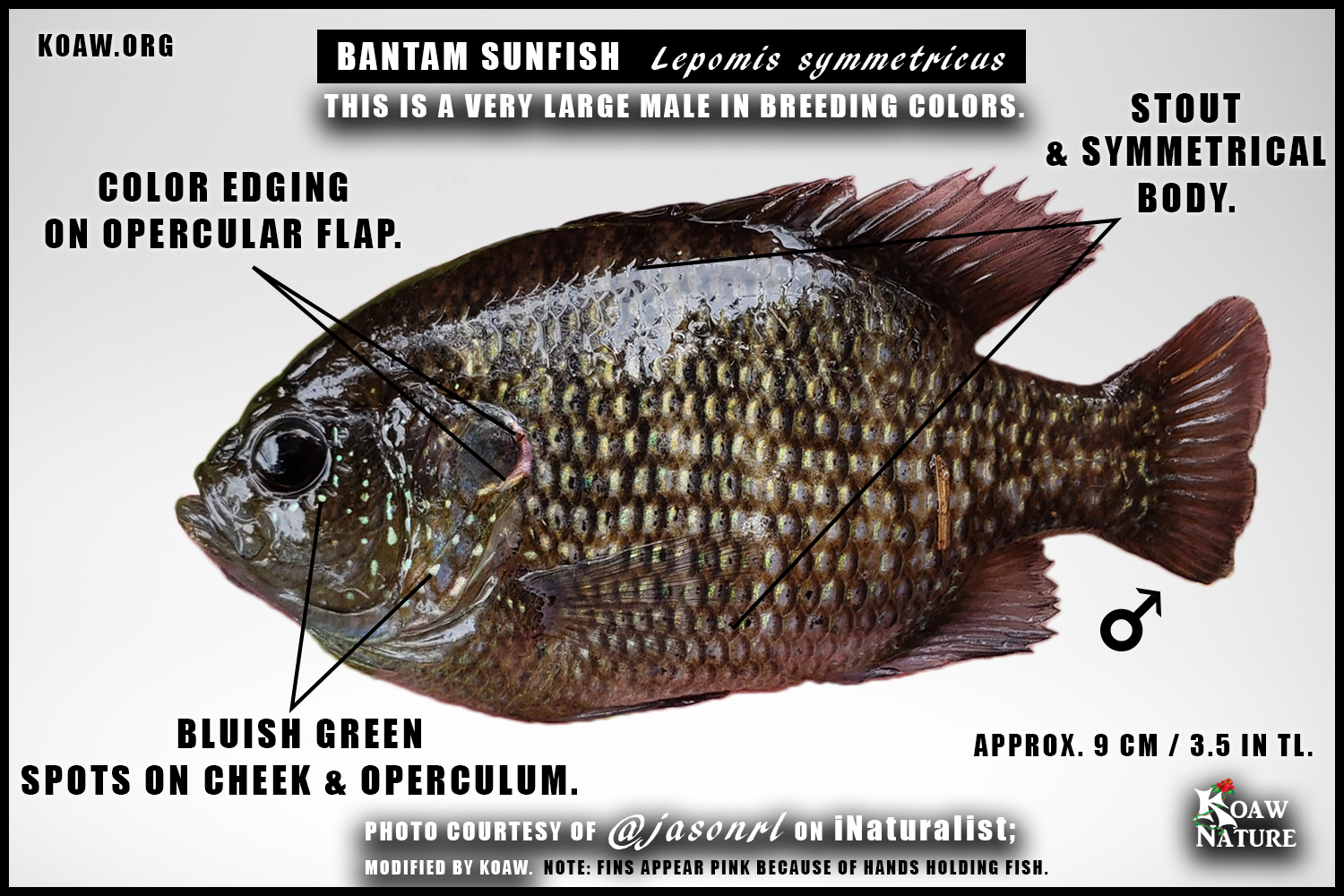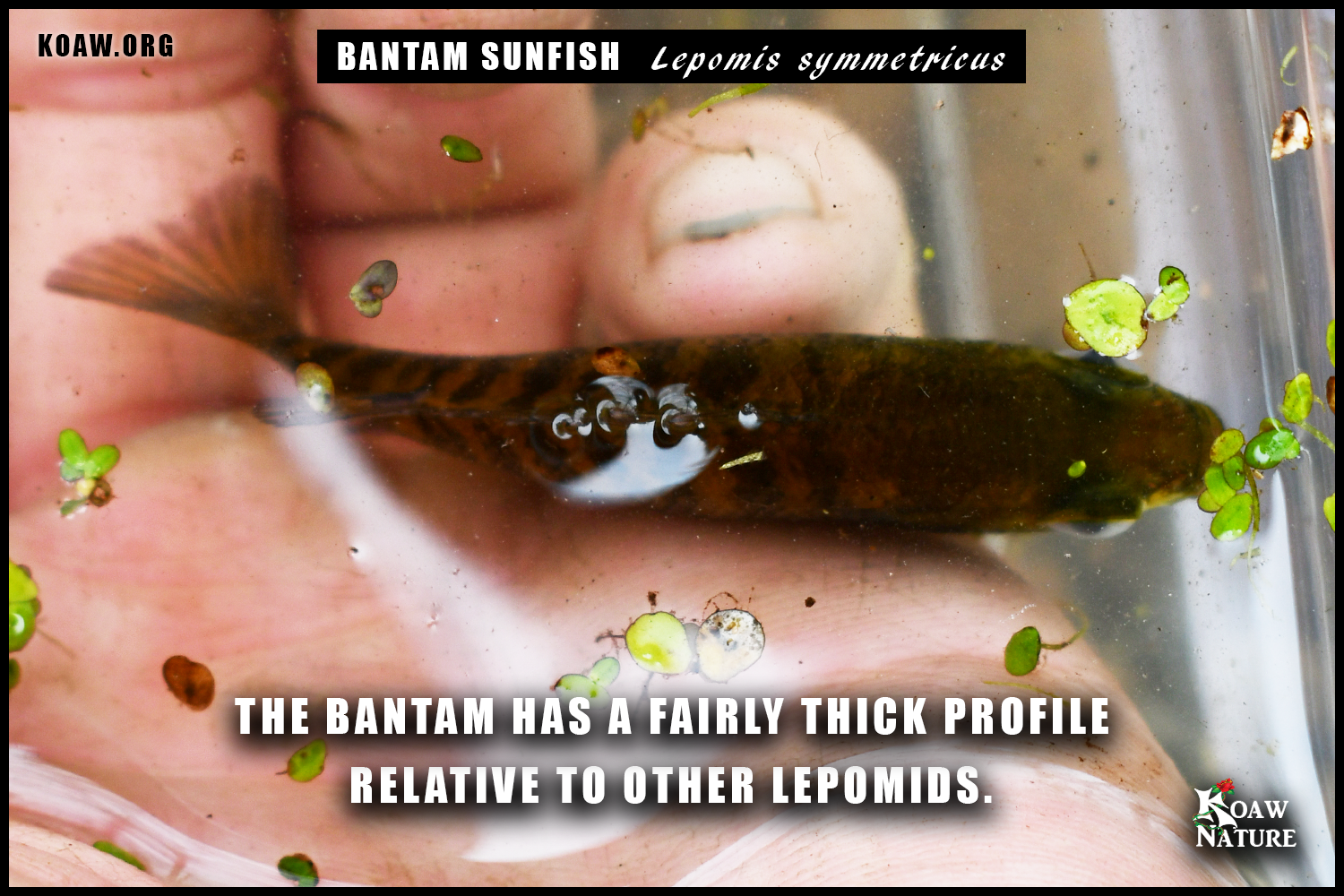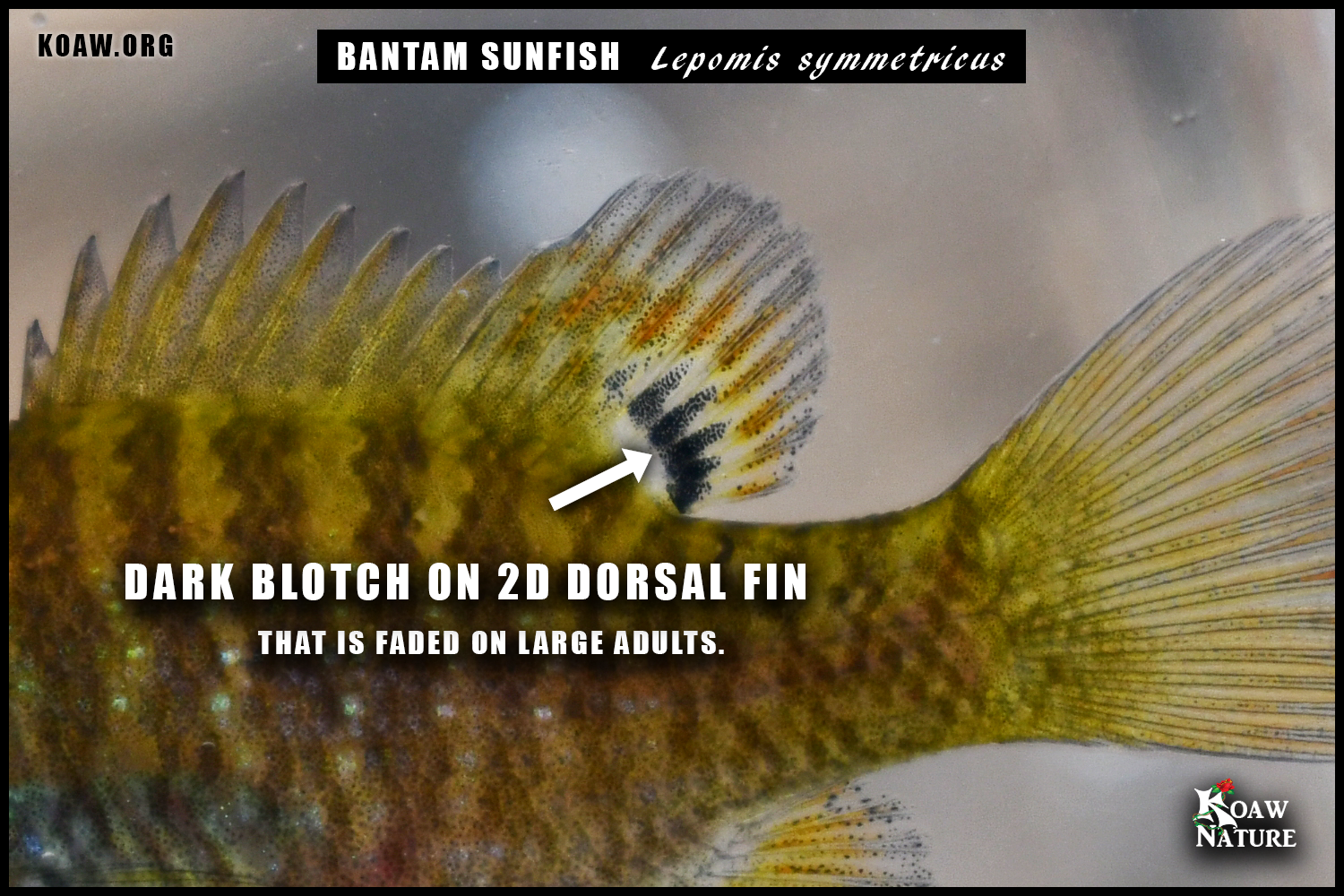By Koaw - November, 2020
GENERAL: The bantam sunfish (Lepomis symmetricus – Forbes, 1883) [1] is the least studied of all the sunfishes within Lepomis. [2] This is the smallest species of lepomid and is generally not targeted by fishers. This species primarily dwells in sloughs and other swamp-like habitats, places most people avoid.
Great features to confirm an ID are looking for a dark blotch in the 2d dorsal fin that will be surrounded by brown, orange or red markings in younger specimens (though the blotch fades on mature specimens and will be entirely absent in large adults), [3] an incomplete lateral line and a very chubby/stout appearance.
BODY: Like all lepomids, the body is deep and compressed though maintains a thicker appearance as an adult than most other sunfishes. The stout, symmetrical shape of the mature body gives the bantam sunfish its common and scientific name.
Click to enlarge.
The bantam sunfish is the only lepomid to usually have an incomplete lateral line; [3] often 1-18 lateral scales will be without pores and interrupted, sometimes up to 6 times. [4] There are 30-38 (30-40) lateral scales. [4] [3]
Typically with 9-10 (11) dorsal spines, 10 (9-12) dorsal rays, 3 anal spines and 10 anal rays.[4][2]
COLORATION: The bantam sunfish is perhaps the most blandly-colored of all the lepomids. Aside from the reddish orange color present in the soft dorsal and anal fins (more prominent in the fall and winter months), [4] not much bright coloration exists on the body with the exception of some bluish, green and yellow iridescence on the anterior portions of the scales, primarily below the midline of the body. Though breeding males and females do tend to gain more color on the head and body.
Juveniles are characterized by always having a large black blotch in the 2d dorsal fin. This blotch is often surrounded by brown, orange or red markings where these colors, as well as the black blotch, will fade with age; the black blotch may still be present on some adults, though usually entirely absent on large adults. Juveniles also have more conspicuous vertical bands along the body, of which, may be more easily perceived as the body of a juvenile is more transparent and less ‘meaty’ than an adult’s body. Males and females typically reach sexual maturity around 1 year of life. Males may reach sexual maturity at approx. 40 mm SL and females 34 mm SL. [4]
Click to enlarge.
Adults also maintain vertical bands of irregular brown spots often with scattered spots between the bars. Typically large adults have a dark olivaceous body that remains lighter ventrally, cream to white on the breast and belly with very small black/brown spots composed of melanophores. [4] Some specimens have thicker, dark discrete spots within the scales on the lateral sides, of which, can be seen on the adult male specimen in the photo carousel above the “GENERAL” & “BODY” categories. These small clumps of melanophores within these scales on the lateral sides seem restricted to large adults.
Nonbreeding males and females look essentially identical and there is no obvious size difference between the two sexes. Breeding males take on a darker head with faded bars on the body while the breast, belly and rest of the underside to the first anal rays may turn grayish black. The edges of the pelvic fins on breeding males may be black with cream-colored membranes between. Both the female and male in breeding colors may develop greenish spots on the cheek and opercle. The opercular flap in breeding males takes on a pale edging that may have colors of faint red, purple or orange. Females in breeding colors develop vertical bars that are bluish purple with iridescent green/blue flecking between.[2][4]
Rarely is there a black blotch in the anal fin of the bantam sunfish such as is typical on a green sunfish (Lepomis cyanellus) and often seen on coppernose bluegill (Lepomis macrochirus purpurascens).[4]
SIZE: The bantam sunfish is the smallest lepomid, typically not reaching sizes greater than 9.0 cm / 3.5 in TL, though larger specimens have been observed in tank settings. [2]
Click to enlarge.
OPERCULAR FLAP: The black opercular flap is often diffuse on small specimens, at times hardly visible. Larger specimens may have white edging around the entirety of the flap where large males in breeding colors may have fainter colors of red, purple or orange amidst the pale edging.
GILL RAKERS: The bantam sunfish has very long rakers relative to their width compared to the other lepomids, however, this species is so tiny that it is extremely difficult to analyze the rakers without harming a specimen.
The photo shows the rakers of the largest specimen collected in Kentucky that was 64 mm; taking a photo of the rakers was rather difficult, hence why my finger is in a third of the photo. (It was my intention not to kill any specimens during this project; normally, for scientific studies, the first gill arch is removed from a preserved specimen and measured with calipers.)
Brooks Burr, during his study of bantam sunfish in Illinois, found the longest rakers were 2.3-2.9 mm long and 0.3-0.5 mm wide, averaging about 7-9 times longer than wide.[4]
I made a video describing how to locate and find these rakers that is hosted on Koaw Nature’s Fishing Smarts YouTube channel.
MOUTH SIZE: The mouth is fairly large to moderately-sized where the upper jaw will most often extend past the anterior edge of the pupil.
More specifically, the most posterior edge of the maxillary will extend past the most anterior edge of the eye’s pupil.
PECTORAL FIN: The pectoral fin is short and rounded, usually not extending past the pupil if bent forward. The pectoral fin will often have 12-13 pectoral rays, less often with 11. [4]
HABITAT: The bantam sunfish’s optimal habitats include swamps, sloughs, ponds, lakes and oxbows. Bantam are associated with fairly undisturbed waters that are heavily vegetated and have plenty of cover like fallen branches. Find bantam over muddy benthic and other bottoms with decaying plant matter. [4]
CLICK TO ENLARGE - This distribution map is an illustrated approximation created by Koaw primarily pulling data and information from Research Grade observations from iNaturalist, Burr’s publication on the Bantam Sunfish (1977) and Page & Burr’s Field Guide to Freshwater Fishes.
LOCATION: : Scattered populations of the bantam sunfish exist in the southcentral United States. Not common but present statewide in Louisiana. Fairly common in eastern Texas, parts of southern Arkansas, northwestern Kentucky and places in western Tennessee. Other populations occur in southeastern Missouri, the very southern parts of Illinois and in one county in Oklahoma’s southeast corner. [4] [3] [5] The Illinois Endangered Species Protection Board lists the bantam sunfish as “threatened” across the state. [6]
The lone blue spot on the map in the northern range marks previous populations of bantam sunfish near Pekin, Illinois around 1880. Bantam sunfish are more than likely completely extirpated from this area as a result of anthropogenic means.[4] Reports of bantam sunfish in southwestern Indiana are likely erroneous as no certifiable vouchers of specimen collections have been found.[2]
FISHING: This was the only lepomid that I did not capture with rod and reel during my 2020 outing to capture the remaining lepomids for this guide. I was a bit too ambitious, fishing with size 10-12 hooks in Missouri hoping to land the largest of mature specimens.
In order to capture specimens of bantam sunfish for this guide I ended up contacting a man named Jason who has had success finding bantam populations in northwestern Kentucky. We used dip nets to capture numerous specimens in a slough. Most all of the specimens we nabbed were between 20-30 mm TL (not sexually mature) though we did get some subadults and adults, the largest being 64 mm TL.
Brooks Burr, upon studying a population of bantam sunfish in Illinois, suggested that it was more common to find specimens during the summer in depths of 60-120 cm (2-4 ft), while in the fall and winter, specimens were more common in shallower water at around 15-30 cm (6-12 in) in depth. [4]
WITH ROD & REEL: It really is microfishing when it comes to the bantam. The multispecies angler who helped me find my first bantams in Kentucky, Jason, suggested using at least a size 14 hook (if not smaller) with the ever so smallest piece of a cut worm. A large adult bantam would have no problem taking a size 10 hook but that probably requires the fisher to go deeper into the muck…so grab your waders!
SIMILAR SPECIES:
REFERENCES:
R. Fricke, W. N. Eschmeyer and R. van der Laan, "ESCHMEYER'S CATALOG OF FISHES: GENERA, SPECIES, REFERENCES," [Online]. Available: http://researcharchive.calacademy.org/research/ichthyology/catalog/fishcatmain.asp. [Accessed Novemeber 2020].
D. K. Zeman and B. M. Burr, "Conservation Assessment for Bantam Sunfish (Lepomis symmetricus)," Southern Illinois University, Dept. of Zoology, Carbondale, 2004.
L. M. Page and B. M. Burr, Peterson Field Guide to Freshwater Fishes, Houghton Mifflin Harcourt Publishing Company, 2011, pp. 506-507.
B. M. Burr, "The Bantam Sunfish, Lepomis symmetricus: Systematics and Distribution, and Life History in Wolf Lake, Illinois," Natural History Survey Division, vol. 31, no. 10, pp. 437-466, 1977.
iNaturalist, "Lepomis symmetricus Bantam Sunfish," iNaturalist, 2020. [Online]. Available: https://www.inaturalist.org/taxa/104257-Lepomis-symmetricus. [Accessed November 2020].
Illinois Endangered Species Protection Board, "CHECKLIST OF ILLINOIS ENDANGERED AND THREATENED ANIMALS AND PLANTS," 2020.


